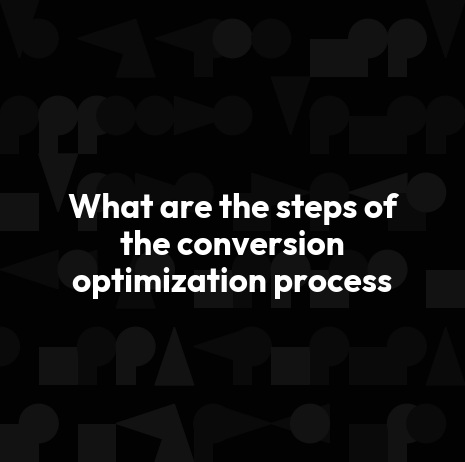- Published on:
What are the steps of the conversion optimization process
- Authors


- Name
- Darjan Hren
- @darjanhren
The CRO process is part of all conversion rate optimization services and is quite complex and takes a lot of steps but you'll find a group of 5 steps below with a solid overview.
Processes and systems are great as they optimize tasks so you can focus on things that move the needle more.
1. Research/Data gathering Phase
This is the phase where you discover potential gains throughout the sales funnel where ab testing improvements would increase conversions.
Research can be technical like looking at Google Analytics and seeing on which browser app, operating system or mobile phone the conversions are low. It may be that there's a bug somewhere that creates friction for the user or even worse, the button for checkout is missing (it happens, trust me).
You can research competitors or even better find out more about your voice of the customer. You survey your customers to learn why they bought your product, what they liked, disliked etc. For users that didn't buy, you can set up exit popups with a question why they didn't finish the purchase.
There many other ways to get qualitative and quantitative data which will help generate ideas and hypotheses.
2. Hypothesis Phase
Form a working hypothesis based on your research phase. Based on the gathered data and insights, you need to make sure that you do this before testing anything. This will lead to you the correct results or goal and learnings if the test wins or loses.
It also creates a focus on how to solve the solution to the hypothesis.
In time you will have a lot of these hypotheses making a custom ideas list that works mostly just for the website you work on. Some conversion rate ideas can be used elsewhere but be careful with the right context.
3. Prioritization Phase
This is where you set the order of tests based on eCommerce metrics. You could use the PIE prioritization framework (Potential, Importance, Ease) to rate the ideas based on importance and what estimated increase in conversion rate would mean for you yearly revenue.
There's no point in doing tests that have 1-5% revenue increase before you do the ones that have higher revenue potential.
This phase is needed so you stop guessing and also show your boss that time spends on other things is a mistake.
Each conversion rate optimization agency can have its own prioritization framework. There are other ones called ICE, ICE 2 or PXL (from CXL)
4. Wireframes, design, UX & development
Based on the hypothesis you will need to create a solution that works starting with wireframes, ideation of the solution. You will then give the design team the brief where they will improve upon it and send it to developers to prepare it for testing.
Some things are easier to test like copywriting, as you can directly set up the test in tools like Google Optimize or WVO. In this case design, UX,... can be skipped.
4. Testing Phase
This is the phase where you use a tool to track the conversion of the A/B split test. Version A is your original and B is the improved version based on your hypothesis, data,...
You send 50% of traffic to version A and other 50% to version B and measure the difference.
The testing tool will usually help choose the winner based on some algorithms and data it gets.
Read more on how long should you let your conversion optimization experiments run (on average).
5. Learning Phase
Either the testing gets you a winner or a loser, you will be able to learn form both. Sometimes you need to improve upon a losing test 3-4 times to iterate and turn it into a winner.
It's a good practice to create reports and share the learning with the team. Conversion rate optimization can help upgrade everyone in the company and bring better results on their own work. Designers, developers, marketing teams will help everyone.
Now that you know what are the steps of conversion optimization process it's time to put things into action. Good luck.